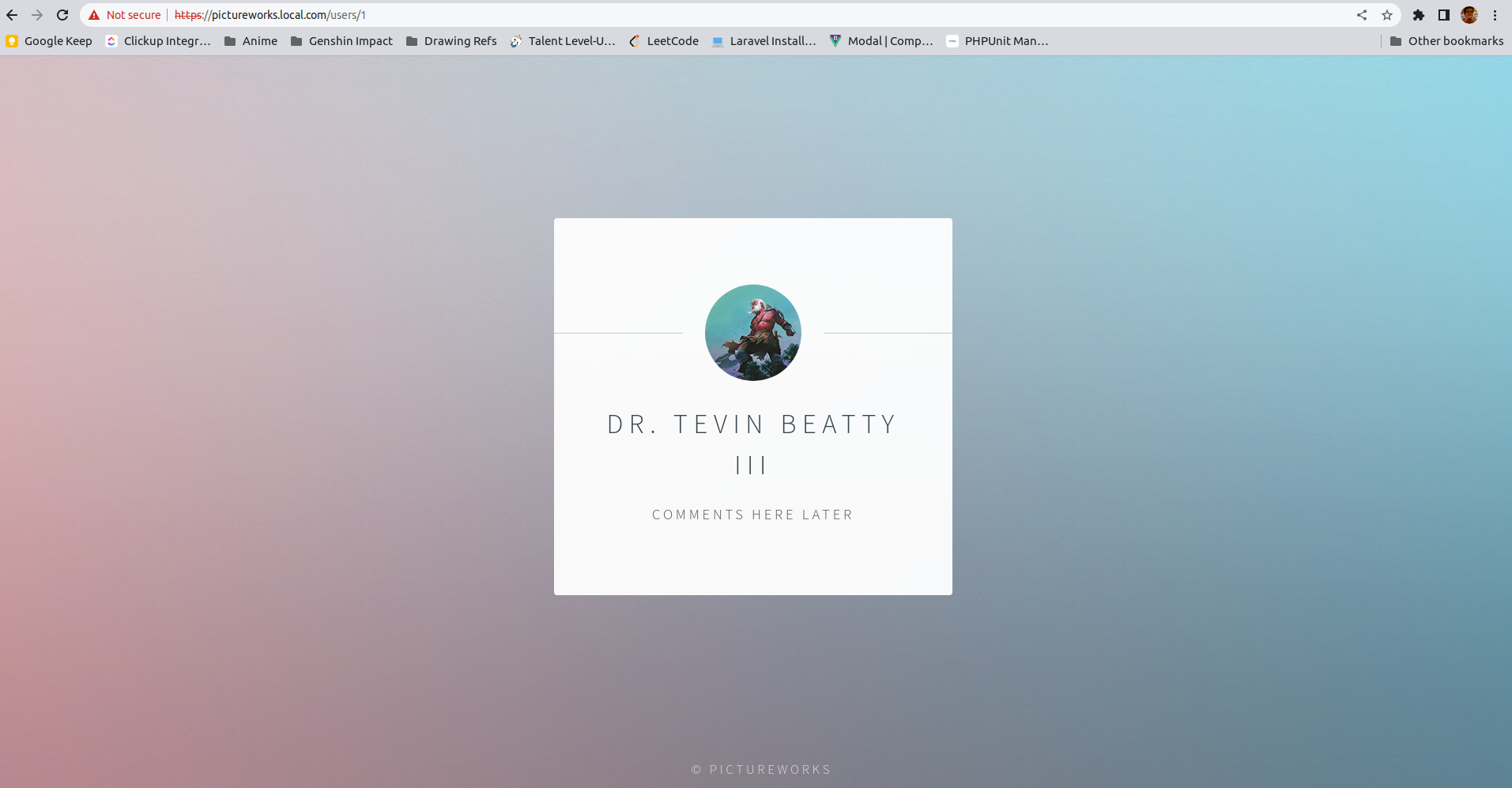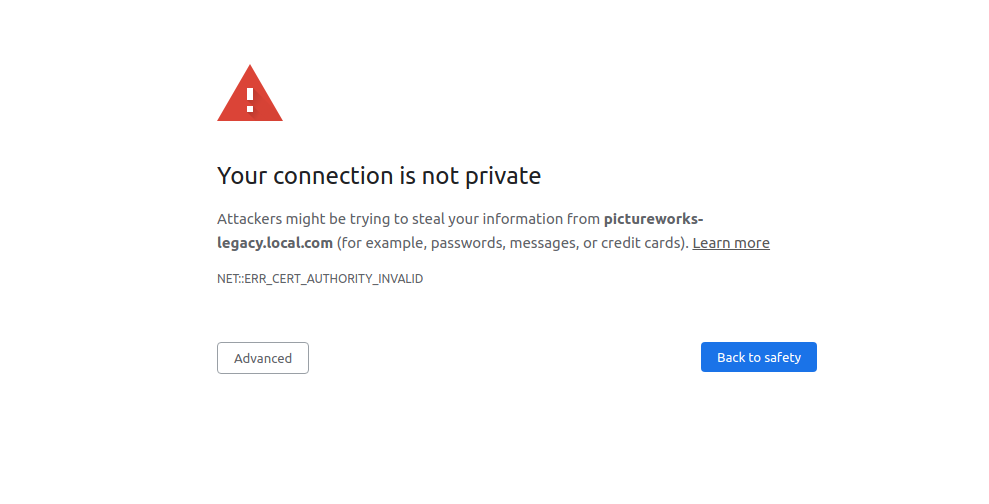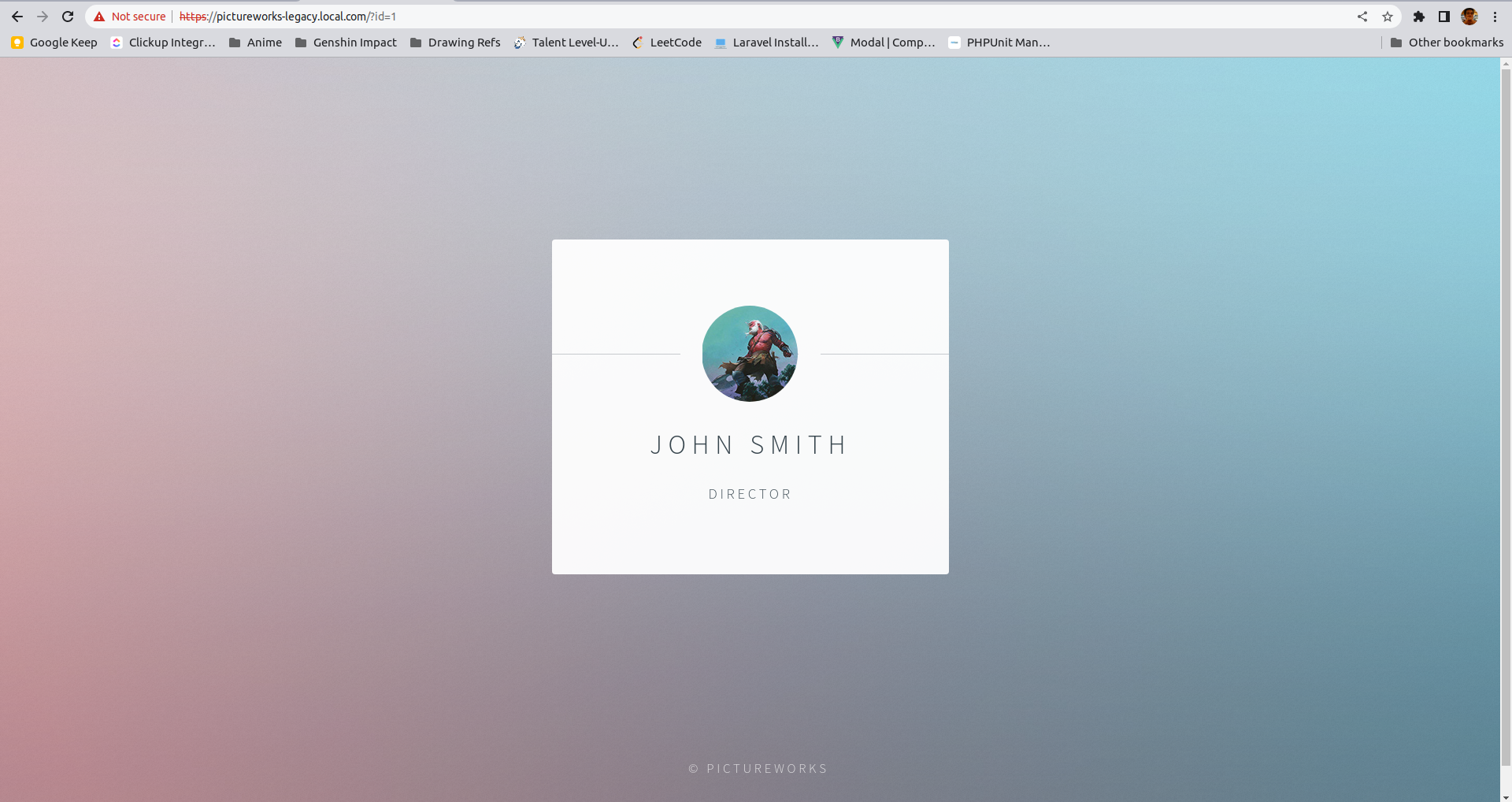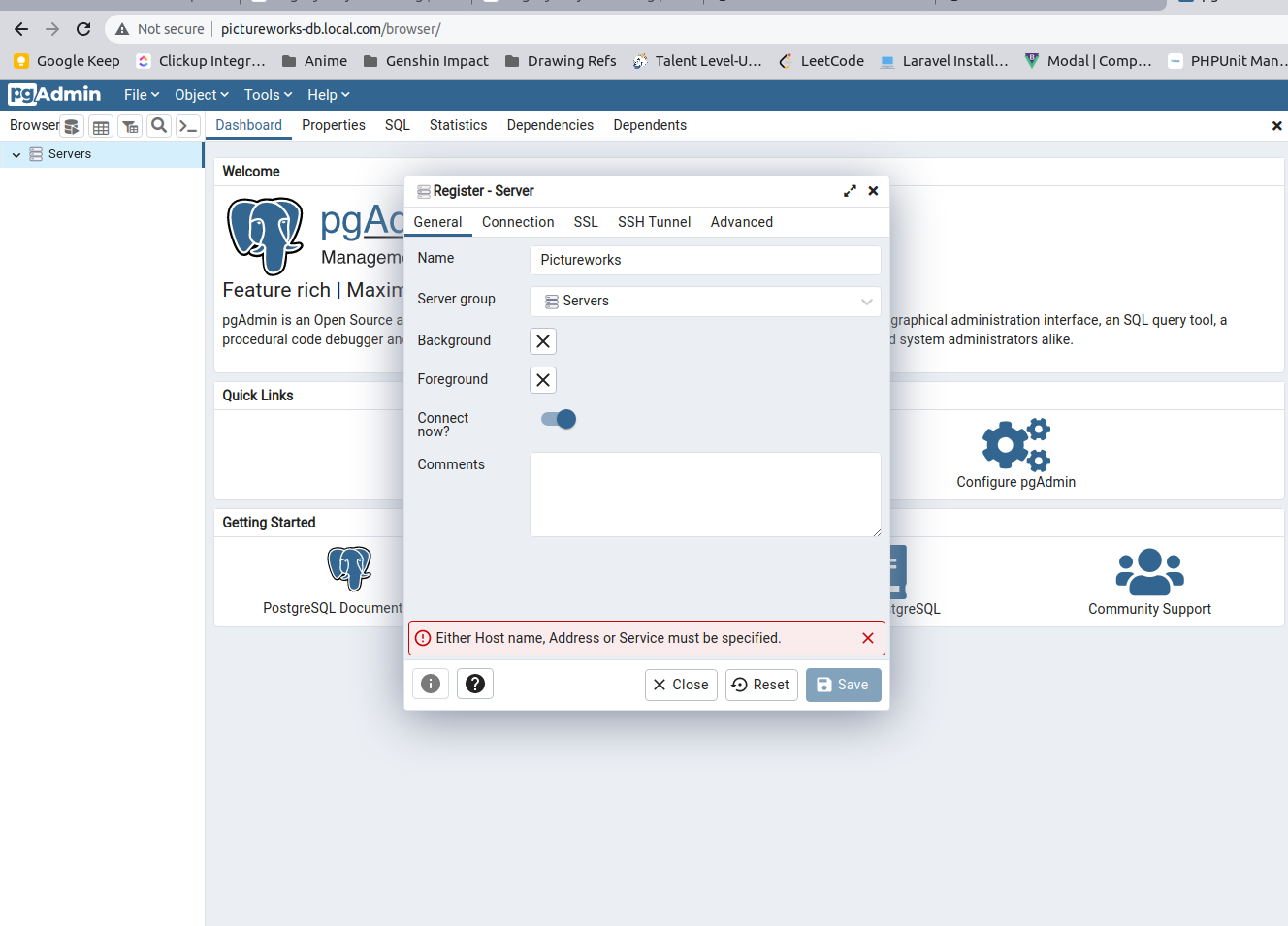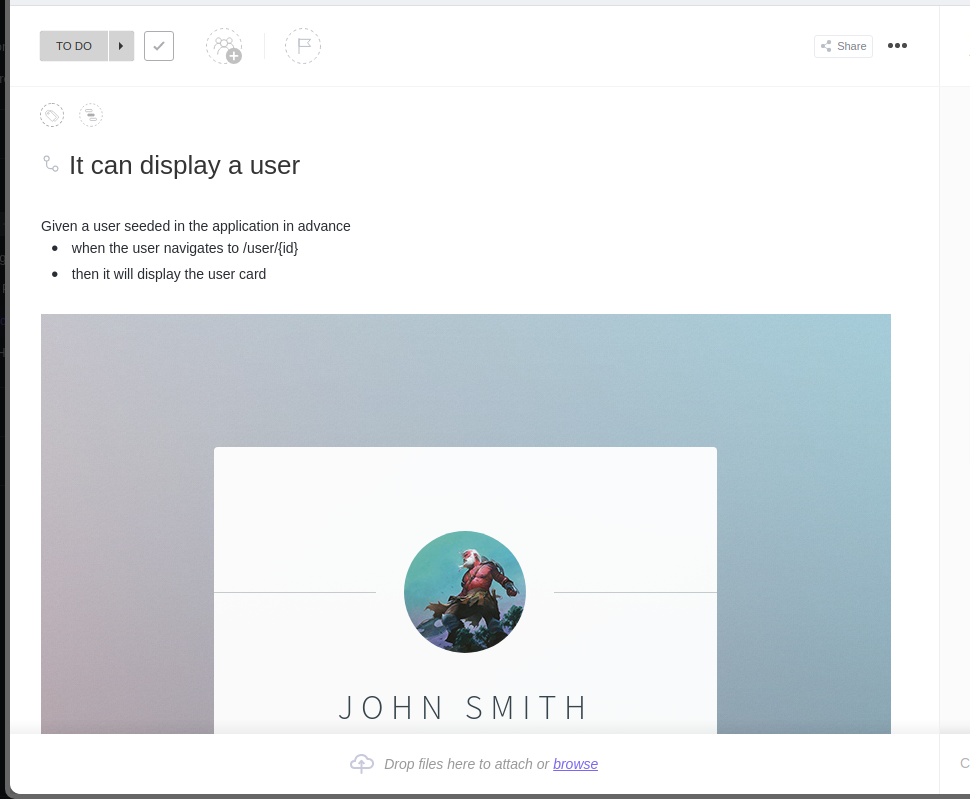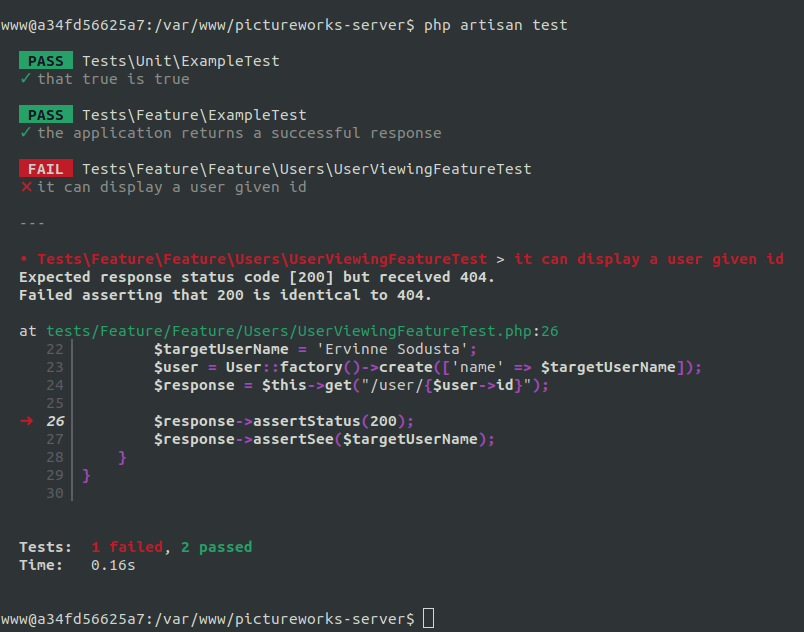The deliverables said to provide "A single laravel application that can replace the legacy application provided.". But the applicant, Ervinne Sodusta would like to take this opportunity to highlight making full use of postman and docker as well to showcase his experience with dealing with legacy systems and porting them.
With a budget of 8 hours, let's try to go above and beyond just providing a new Laravel app and try to showcase how we would handle legacy systems like we do with our usual work. Development time is documented via Clickup.
We ran out of time but ideally, we should've used something like: https://beyondco.de/docs/laravel-apidoc-generator/getting-started/generating-documentation.
For now, let's manually do the documentation:
| Method | Path | Dest |
|---|---|---|
| GET | users/{id} | UserController@show |
| POST | api/v1/users/{user}/comments | UserCommentController@store |
| POST | api/v1/comments | UserCommentController@storeWithLegacyRequest |
This displays the user and his comments if it exists. it should look something like:
This is the API route designed if the restrictions of 1:1 is lifted. It uses a proper route where the subject of the update is in the route param - user, and only the comment and the password is in the request body. Notice the use of singular comment instead of comments.
This is NOT the answer to the instructions, merely an additional route to represent what could be some improvements we can do if we are not constrained by a 1:1 copy of the old API signature.
Example uri: api/v1/users/1/comments where 1 is the id of the user we will attach the comment to.
| Parameter | Desc |
|---|---|
| comment | String, max 100 characters, the comment to attach to the {user} |
| password | A static value that serves as the application key |
The applicant also suggests that instad of a static application key passed in the body of the request, we can either do usual oath or jwt keys in the bearer token representing the current user (and we will have to update the route so that it wont contiain the user id). Or use something like this: https://github.com/ervinne13/mutual-authentication-protected-server
This is a 1:1 copy of the original controller.php route relating to writing a comment. This is the actual answer to the ask in the PDF file instructions.
| Parameter | Desc |
|---|---|
| id | The id of the user where we will attach the comment to |
| comment | String, max 100 characters, the comment to attach to the {user} |
| password | A static value that serves as the application key |
In order to make the most of this project. The author, Ervinne Sodusta recommends to run this with docker and docker compose:
https://docs.docker.com/get-docker/ https://docs.docker.com/compose/install/
If you cannot install docker in your machine, then run the project inside pictureworks-server as you would a normal laravel application
Simply execute the following commands:
cp .env.example .env
sudo ./setup.sh
docker compose up
You also have the option to run docker compose up -d to run it detached from the terminal but the author suggest to run this without -d the first time at least to double check any issues if ever the default .env.example configuration had conflicts with your docker network.
The ./setup.sh script would edit your /etc/hosts file in order to put aliases to pictureworks-legacy.local.com and pictureworks.local.com. Please remove these entries manually to clean up.
Access the alias in your browser: https://pictureworks-legacy.local.com?id=1
You will be prompted with a "Your connection is not private" error as we are using self signed certificates to implement a locally enabled ssl. Simply click on "Advanced" and "Proceed to pictureworks-legacy.local.com (unsafe)" to proceed to the application and you should see the following if ./setup.sh did it's job right.
If the proctor wishes so, the applicant may discuss in the interview about his reasoning why he would normally develop with ssl right away starting from his local environment.
The new port will use Postgres instead of MySQL.
The docker setup should automatically create a database and a pgadmin for you automatically. You just need to access http://pictureworks-db.local.com/ or whatever the value of PGADMIN_ALIAS in the .env.
Once you're able to access pgadmin, simply register a new server using the details and credentials you set in your .env.
Set it up first with:
docker exec -it pictureworks-server php artisan key:generate
docker exec -it pictureworks-server php artisan migrate:refresh --seed
If in case this fails and it says that the autoload.php can't be loaded. Then it probably means we are running this project in a folder owned by root.
We can fix this by running
docker exec -it pictureworks-server composer install
docker exec -it pictureworks-server composer dump-autoload
as likely the composer commands failed when docker tried to set it up. Then try to run key generate and the migrations again.
After setting up, visiting https://pictureworks.local.com/users/1 (or use the virtual host you specified in the NGINX_ALIAS if you changed it). You should see the following:
Teardown and reset the databases first with:
Legacy:
docker exec -it pictureworks-legacy-mysql-db /bin/sh -c 'mysql -p<root pw> pictureworks < /docker-entrypoint-initdb.d/init.sql'
replace <root pw> with the value of LEGACY_DB_ROOT_PASSWORD in our main .env.
Port:
docker exec pictureworks-server php artisan migrate:refresh --seed
docker exec -it pictureworks-legacy-mysql-db mysql -p
If given the chance, the author would always try to opt for a Test Driven Development project.
Let's take requirement #5 for example:
Parts 1-4 above should be ported with expected functionality using native Laravel behavior (e.g. url “? id=x” should be available via "/user/{id}").
After planning the tasks, we can go through them one by one and write tests based on each of them:
With a resulting test on "Red State" Feature test:
<?php
namespace Tests\Feature\Feature\Users;
use App\Models\User;
use Illuminate\Foundation\Testing\RefreshDatabase;
use Illuminate\Foundation\Testing\WithFaker;
use Tests\TestCase;
class UserViewingFeatureTest extends TestCase
{
use RefreshDatabase;
/**
* A basic feature test example.
*
* @test
* @return void
*/
public function it_can_display_a_user_given_id()
{
$targetUserName = 'Ervinne Sodusta';
$user = User::factory()->create(['name' => $targetUserName]);
$response = $this->get("/user/{$user->id}");
$response->assertStatus(200);
$response->assertSee($targetUserName);
}
}If ever we have a need for some Unit Tests, we write them as needed in between feature tests. For this case scenario though I doubt we have a need for it as this is just direct query with not much regression risk related to logic. Let's apply YAGNI and KISS and stick to just a feature test specifically for this.
Running this should put us on "Red State":
Note that we can forward this to green state with just a simple:
<?php
namespace App\Http\Controllers;
use App\Models\User;
class UserController extends Controller
{
/**
* Display the specified resource.
*
* @param \App\Models\User $user
* @return \Illuminate\Http\Response
*/
public function show(User $user)
{
return $user;
}
}Nothing wrong with that, then we just refactor and add a view according to the original view. But first, let's fill up the actual db with some data:
docker exec -it pictureworks-server php artisan migrate:refresh --seed
Testing here should put us to green. Now we just refactor so that it will return a view instead of the data directly, run the tests again, and we're done.
Comments
We do a similar approach to comments and write our first test:
<?php
namespace Tests\Feature\Users;
use App\Models\User;
use Illuminate\Foundation\Testing\RefreshDatabase;
use Carbon\Carbon;
use Tests\TestCase;
class CommentCreationFeatureTest extends TestCase
{
use RefreshDatabase;
/**
* A basic feature test example.
*
* @test
* @return void
*/
public function it_can_write_a_comment_for_a_user()
{
$targetUserName = 'Ervinne Sodusta';
$user = User::factory()->create(['name' => $targetUserName]);
$pw = env("APPLICATION_KEY");
$ts = Carbon::now()->toDateTimeString();
$comment = "This is a test comment {$ts}";
$response = $this->post("/users/{$user->id}/comments", [
'comment' => $comment,
'password' => $pw
]);
$response->assertStatus(200);
$response->assertSeeText("OK");
$this->assertDatabaseHas('comments', [
'user_id' => $user->id,
'comment' => $comment
]);
}
}In this case though we'll be breaking the rule:
As a general overarching rule: regardless of access method, as long as your code has the exact same input and output as the legacy app, you have done the right thing.
Let's do this first and then add another route solely for comments to satisfy the rules. The applicant will present both solutions and negotiate if the first implementation can be used.
We just then do the same thing and implement everything, add a few more negative tests to test something like it_fails_if_user_does_not_exist and we're done.
Legacy systems are usually hard to setup locally, especially in the applicant's case where we deal with at least 2 (used to be 3, one was already ported) legacy systems at the same time, which all have different requirements, installed dependencies, etc.
Docker will be an indispensable tool when we start working with legacy systems, whether that would be to keep them and still develop features on it, or have developers run a copy locally and port it.
The applicant Ervinne Sodusta, is used to dealing with multiple legacy systems (mostly MERN nowadays) at the same time and have used docker extensively to resolve issues about having multiple versions of the databases for example in his own machine without interfering with each other.
With a little bit more of effort of writing bash files on top of our docker. We can now make it easier for multiple developers to work on the project and run it locally without much hassle and turnover, saving senior developer's (or whoever the guy who knows the legacy app by heart) time.
We'll showcase it's API testing feature and environment feature to showcase a 1:1 comparison of 2 project's APIs.
init.sql and Database Setup
init.sql containing schema updates are fine, but updates to database like inserting data should not be in it or in the repository at all.
The normal way to do this is to upload it somewhere and automate downloading it via aws s3 cp (or curl if we don't have AWS). Since it only had 1 entry without sensitive information, we just included it in the init.sql anyway.
Files required by the legacy app is nice to be stored in an s3 bucket since we can just write an IAM user with limited capability and we can now suddenly securely download it with the credentials of that IAM user saved in our .env. The applicant haven't personally done it anywhere else, but if we would use curl for it and be unable to put security measures in it aside from password protecting the zip file and saving the password via .env.
Ask this from the proctor, maybe this is not the case really in the actual legacy system but if it is, propose the use of mutual authentication: Mutual Authentication Protected Server.
Since the document said that:
provided the 'password' is a given static value
the password must be some sort of application key. While SSL encrypts the request body, it's still not recommended to put it here. We can do mutual authentication for server to server communications, or application keys saved in the Authorization header of the request.
Another reason of using docker is that we can just setup and teardown databases for postman testing. We didn't do that here (or at least not yet, check if we still have time).
Also, there could be better tools than postman for the job and the applicant haven't explored them yet so this is all he can showcase for now.
